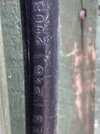If you can measure the overall diameter of the cable, 15mm would be 4mm2, 17.5mm would be 6mm2 and 19mm would be 10mm2.
Current carrying capacity is dependant on how the cable is installed; cables heats up the more current they carry so it's all about how the cable can dissipate that heat safely. Electricians install fuses and breakers to limit (down rate) the current carrying capacity to protect the cables.
Current carrying capacity is dependant on how the cable is installed; cables heats up the more current they carry so it's all about how the cable can dissipate that heat safely. Electricians install fuses and breakers to limit (down rate) the current carrying capacity to protect the cables.


